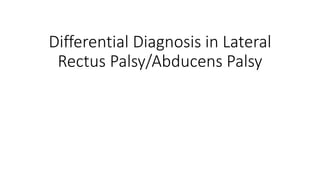Differential Diagnosis in Lateral Rectus Palsy
•Download as PPTX, PDF•
12 likes•3,774 views
Report
Share
Report
Share

Recommended
Recommended
More Related Content
What's hot
What's hot (20)
Approach to Dizziness and Vertigo in Emergency Department

Approach to Dizziness and Vertigo in Emergency Department
Neurocutaneous Markers and Congenital malformations - Dr. S. Srinivasan, Prof...

Neurocutaneous Markers and Congenital malformations - Dr. S. Srinivasan, Prof...
Viewers also liked
Viewers also liked (11)
TargetInsights: A New Method to Rapidly Access 'Specificity” of Selected Prot...

TargetInsights: A New Method to Rapidly Access 'Specificity” of Selected Prot...
Anatomy of fourth and sixth cranial nerve 06.12.13

Anatomy of fourth and sixth cranial nerve 06.12.13
Similar to Differential Diagnosis in Lateral Rectus Palsy
Similar to Differential Diagnosis in Lateral Rectus Palsy (20)
Ocular nerve palsy - 3rd, 4th and 6th cranial nerve palsy

Ocular nerve palsy - 3rd, 4th and 6th cranial nerve palsy
BRAINSTEM LESION INVOLVING 3rd,4th and 6th cranial nerve

BRAINSTEM LESION INVOLVING 3rd,4th and 6th cranial nerve
neurosurgery.Congenital anomalies of the cns,(dr.mazn bujan)

neurosurgery.Congenital anomalies of the cns,(dr.mazn bujan)
More from Randy Rosenberg MD FAAN FACP
Randy Rosenberg MD FAAN FACP shares his expertise in neurology and 50 years of musical performance to a conversation about how the brain decodes, interprets and, at times, corrupts the appreciation of music, melody and rhythm.
Topics to be explored will include the neurophysiology of listening, tone deafness, musical hallucinations, synesthesia, hearing loss in musicians and the often tragic stories of composers and performers afflicted with neurological illnessThe Musical Brain: Neurological Curiosities of Music, Musicians and the Rest ...

The Musical Brain: Neurological Curiosities of Music, Musicians and the Rest ...Randy Rosenberg MD FAAN FACP
More from Randy Rosenberg MD FAAN FACP (20)
Progressive supranuclear palsy richardson syndrome 060419

Progressive supranuclear palsy richardson syndrome 060419
Fantastic facial movements and where to find them 111118

Fantastic facial movements and where to find them 111118
The Musical Brain: Neurological Curiosities of Music, Musicians and the Rest ...

The Musical Brain: Neurological Curiosities of Music, Musicians and the Rest ...
Differential Diagnosis in Lateral Rectus Palsy
- 1. Differential Diagnosis in Lateral Rectus Palsy/Abducens Palsy
- 2. CN VI (Abducens Nerve) • Longest subarachoid course • Runs from brainstem in posterior fossa, through middle fossa (especially the petrous apex) and orbit • Lesions can affect the nerve via: VI1: the brainstem syndrome VI2: the elevated intracranial pressure syndrome VI3: the petrous apex syndrome VI4: the cavernous sinus syndrome VI5: the orbital syndrome
- 3. Anatomical Concerns • Course of the Abducens Nerve
- 4. Brainstem Sources of Abducens Palsy • Millard Gubler Syndrome • A unilateral lesion of the ventrocaudal pons may involve the basis pontis and the fascicles of cranial nerves VI and VII. Symptoms include: • 1.Contralateral hemiplegia (sparing the face) due to pyramidal tract involvement • 2.Ipsilateral lateral rectus palsy with diplopia that is accentuated when the patient looks toward the lesion, due to cranial nerve VI involvement. • 3.Ipsilateral peripheral facial paresis, due to cranial nerve VII involvement.
- 6. Foville Syndrome: Inferior Medial Pontine Syndrome (Foville Syndrome) • Foville’s syndrome: Sixth nerve paresis Horizontal conjugate gaze palsy Ipsilateral V, VII, VIII cranial nerve palsy Ipsilateral Horner’s syndrome
- 7. Foville Syndrome • Ipsi PPRF --> Horizontal Gaze palsy • Ipsi CNVII --> LMN facial paresis • contra UMN paralysis of body • contra sensory loss of body • internuclear opthalmoplegia
- 8. Anatomical Consideration of the Petrous Apex
- 9. Petrous Apex Syndrome (Grandenigo’s Syndrome) • retroorbital pain due to pain in the area supplied by the ophthalmic branch of the trigeminal nerve (fifth cranial nerve), • abducens nerve palsy (sixth cranial nerve),[3] and • otitis media
- 10. Intracranial Abducens Dorello canal channels the abducens nerve (CN VI) from the pontine cistern to the cavernous sinus
- 11. Increased Intracranial Pressure • Brainstem displacement inferiorly • Diffuse pressure along the subarachnoid course • Traction on CN VI while it is anchored in Dorello’s canal Diplopia--> Horizontal
- 12. Extracranial course of CN VI Note the Abducens in within the cavernous sinus while the CNIII, V1, V2 and Trochlear nerves are in the wall CN VI exists the eye at the superior orbital fissure
- 13. Superior Orbital Fissure • Learn • Fauna • To • See • Numerous • Invertebrate • Animals
- 14. In adults, the most likely etiology of isolated sixth nerve palsy is ischemic mononeuropathy that may be due to diabetes mellitus, arteriosclerosis, hypertension, temporal arteritis or anemia Isolated 6th Nerve Palsy
- 15. Six Mimics of a CN VI Palsy Thyroid eye diseases Myasthenia gravis Duane’s syndrome Spasm of the near reflex Delayed break in fusion Old blowout fracture of the orbit
- 16. Duanes Retraction Syndrome • Defect in genesis of Abducens nucleus • Three components” • Defect AB duction • Some defect in AD duction • Palpebral fissue narrowing and globe retraction often with upshoot
